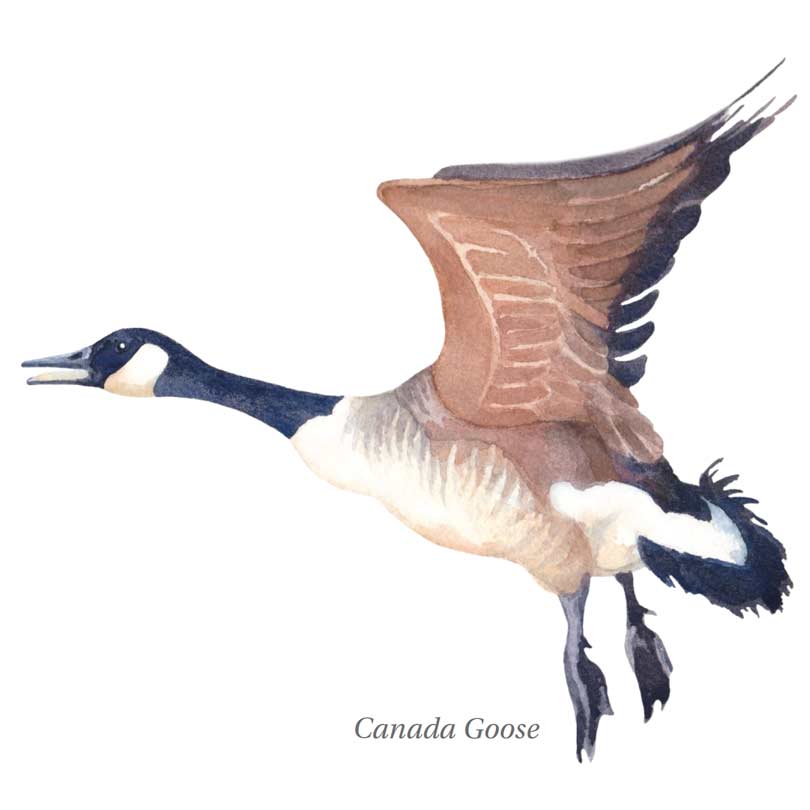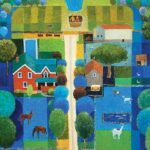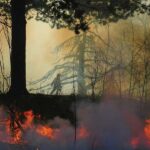
A few short years ago, a V-shaped skein of migrating Canada geese was a rare sight, as spring and fall were the only times we ever saw them. This revered symbol of the Canadian wilderness was once the truest sign of the changing seasons. Geese heading northward brought the promise of spring and erased the bleakness and bitter blasts of winter. Their southward flight in fall foretold the coming of dark snow clouds and icy winds.
Until the mid-1970s, local or resident Canada geese were nonexistent in the Watershed region. The legions of migrating honkers rarely landed in our fields or rested on our waterways. When they did appear, the sound of their honking would draw our eyes to the sky as we strained to catch sight of these majestic birds. In less than a minute the flock would disappear over the horizon, and then they were gone. A seasoned waterfowl hunter would prize the Canada goose as the ultimate trophy for the table during the fall hunting season, but rarely did a goose grace that table.
In the late 1960s, news spread throughout Cobourg that a local hunter had taken a Canada goose and was showing it off at the local pool hall across from Victoria Hall. I rushed home from high school armed with the story and told my dad the incredible news. He was impressed and said it was possible that a flock of geese may have landed in the area. He remembered in the late 1940s on his home farm near Lake Scugog that a flock of geese had lit unnoticed in their back field and spent the night. He had stood in awe as he watched them take off at daybreak the next morning. The following Sunday, the local church congregation was abuzz with the story. Old timers told of the vast powers that geese possessed and that no one could ever sneak up on them because they could see in the dark.
Harold Hanson, a wildlife biologist based in Minnesota, identified the giant Canada goose in the early 1960s and his conservation efforts are responsible for today’s resident geese. (The giant Canada goose is a subspecies of Branta canadensis weighing between 12 and 22 pounds and at the time was believed to be extinct or mythical.) Fears were growing over the extinction of Canada geese as they were being slaughtered on their wintering grounds and the numbers of migrating birds were dwindling.
Dr. Hanson initiated several conservation programs, and soon federal and state agencies joined a national effort to save the geese. Eggs were transported across the country and incubated in several states. His intentions were laudable but in some ways the conservation program was too successful: these giant honkers were nonmigratory and simply flew to the nearest open water in winter. Gravitating to urban environs, free of predators, and with plenty of parkland sporting their favourite fodder of short grasses to munch on, the geese flourished. Every spring and fall the giant Canadas talked to their migrating kinfolk overhead and convinced some of them to drop in. Voilà – the resident Canada goose became permanent and now stays all winter. They are found in all but the prairie provinces in Canada; they now outnumber migrating birds by a healthy margin.
The explosion of local Canada geese is not always championed as a victory for conservation.
It’s no secret that geese are not welcome in urban settings. They overgraze and soil parkland, lawns and golf courses. They are fierce defenders of their nests and young and will attack humans who tread too close. Today, resident geese stand with one webbed foot in civilization and one firmly in nature. Love ’em or hate ’em, humans have created this problem and we must now learn to live with these majestic birds.
Story by:
Roger Thomas




